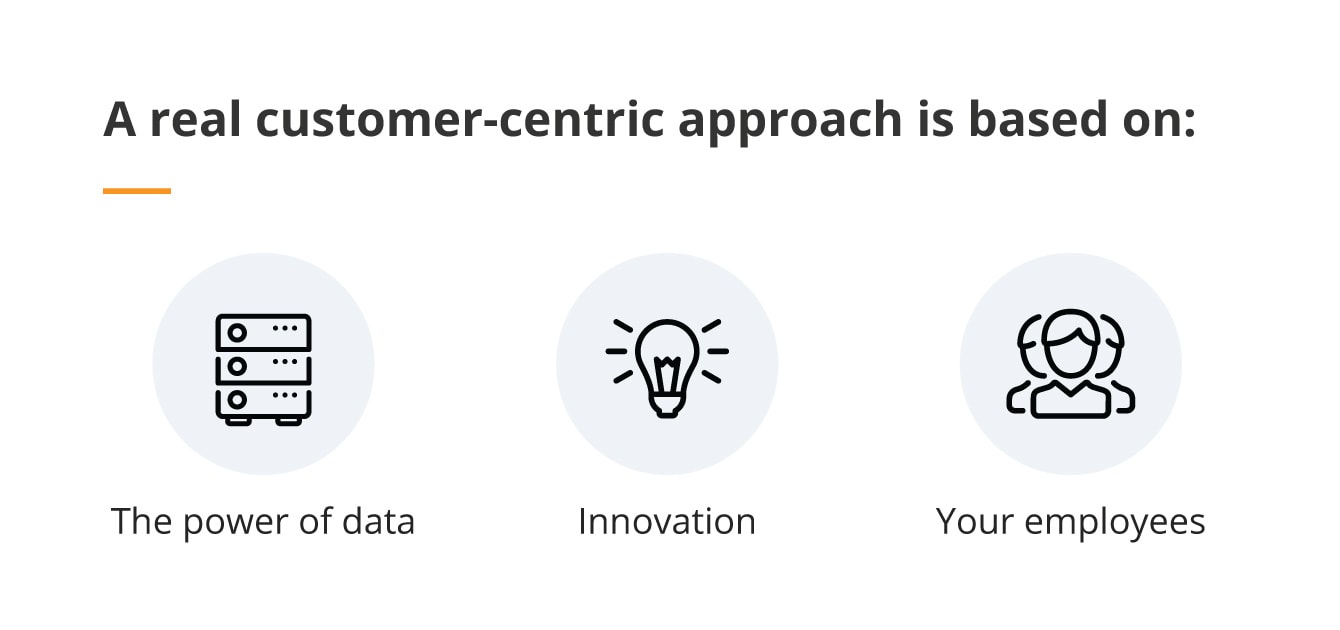
Analysis & Design
Prioritising your customers during your business transformation
date:
13 April 2021
reading time:
6 min
Almost every business owner would claim that they always prioritise their customers’ needs. However, their customers might disagree with this statement. Why? Because many companies are still using old methods to solve new problems, and offering new products based on their legacy architecture. As a result, their customers aren’t getting what they really need, making them feel like they’re actually not being prioritised at all.
Let’s take a look at how we can change this and actually make your customers the lifeblood of your organisation.
Place your customers at the heart of your business transformation: 3 mind shifts
1. Stop guessing. Identify actual customer needs.
- Do the research and take a customer-centric approach.
The decision-making process should always be based on relevant data, and your customers should be the driving force behind nearly each and every one of your decisions, placing them right under the spotlight of your company’s activities.
This makes checking up on them on a regular basis the key to success. You need to know about your customers’ needs and requirements and what makes them choose to stick with you and the product or service that you’re offering – over all the other options on the market. And, of course – how their needs and requirements change over time. For example, you can conduct surveys, ask your clients for feedback and about their expectations, have them rate your offer, and test your service. - Analyse your target audience as well as your competitors.
Asking direct questions is very important. However, you should also learn how to read between the lines and analyse customer behaviour, including their lifestyles, habits, and more. Monitor the way they use your products, what they seem to value the most, and what they totally ignore.
It’s also important to keep an eye on your competitors and observe how they respond to their own customers’ needs. This is a great source of information – one that you cannot afford to overlook. - Help your customers interact with your business in real time, so that you can react quickly.
Nowadays, the ability to respond immediately to any reported issues or questions may be a crucial factor in determining your company’s position, or even survival, in the market.
You need to provide your customers with the tools they need to interact with you in real time – and equip your employees with solutions that enable lightning-fast reactions.
2. Stop building new solutions on top of old systems. Bet on innovation to stay afloat.
- Hire an external IT partner to help you transform your business.
You may, of course, try to handle your digital transformation on your own, but it’s wise to at least consider other options. Hiring an IT partner is a good one. Why? Because your IT department is most likely already occupied with a lot of ongoing tasks and getting them involved in a new and demanding project may be too much for them to handle. And expanding your team may consume too many resources and too much energy.
A good IT partner, on the other hand, will provide you with a team of specialists tailored exactly to your needs, and take comprehensive care of your digital transformation, whether you decide to start small or go big. - Reimagine the customer experience: come up with a new strategy.
If you want to put your clients front and centre and transform your business in line with this new approach, you definitely need to have a good strategy to make it work. Most likely, you already have some thoughts and ideas on this topic, but it would be better to run them by someone else first – preferably an expert who can offer experience and a fresh eye.
Our discovery workshop may be the perfect solution here. - Modernise your legacy system or build a new one from scratch.
Depending on your digital transformation strategy, you may only need to update and modernise your software or you may want to build a new solution from scratch. Either way, the shift is inevitable, because you cannot truly prioritise your customers if you’re still relying on legacy systems. This is also associated with improving customer experience – the better it is, the more likely your clients are to reach for the products or services that you offer, and to keep coming back for more.
Changing your attitude requires betting on innovation and inscribing it deep within your company’s DNA, since the clients are now much more aware of the ongoing trends than only a few years ago.
3. Stop limiting your employees. Empower them instead.
- Listen to their feedback, suggestions and ideas.
Start with empowering and listening to your employees – especially the ones who work on the front lines and are the closest to your customers. They are a true treasure trove of information about your clients, so even their smallest and most insignificant suggestions may help you adjust your course and finally start moving in the right direction. - Make sure that they have all the tools they need to ensure smooth customer service and analyses.
Your customer service should be as effective as possible (for both sides), not to mention pleasant and enjoyable. Your clients should receive the best user experience possible, and your employees should not only be able to help them in any way necessary, but also analyse their feedback and behaviour effectively, so that they can draw adequate conclusions. Equipped with the right tools, your customer service team can help lay the foundation for your transformation. - Take care of your employees, so they can take care of your clients.
This may appear to be obvious, but it’s not nearly as simple as it sounds. Actually, a lot of companies struggle with establishing a pleasant and friendly work environment, fail at creating a supportive atmosphere, and don’t really care about motivating the people they hire. And these people, in turn, take it out on the customers. This is why you need to start by building a great workplace – one that will keep your employees satisfied and motivated enough to offer a similar level of concern when they connect with your clients.
Wrap-up
As you can see – when transforming your business, you need to incorporate a real customer-centric approach.
And this often requires redesigning your entire strategy and reorganising the way you work by getting rid of any legacy systems that may be holding you back.
So, if you’re not sure how to do it right, don’t hesitate to ask for help. We will be happy to assist you in any way we can.




